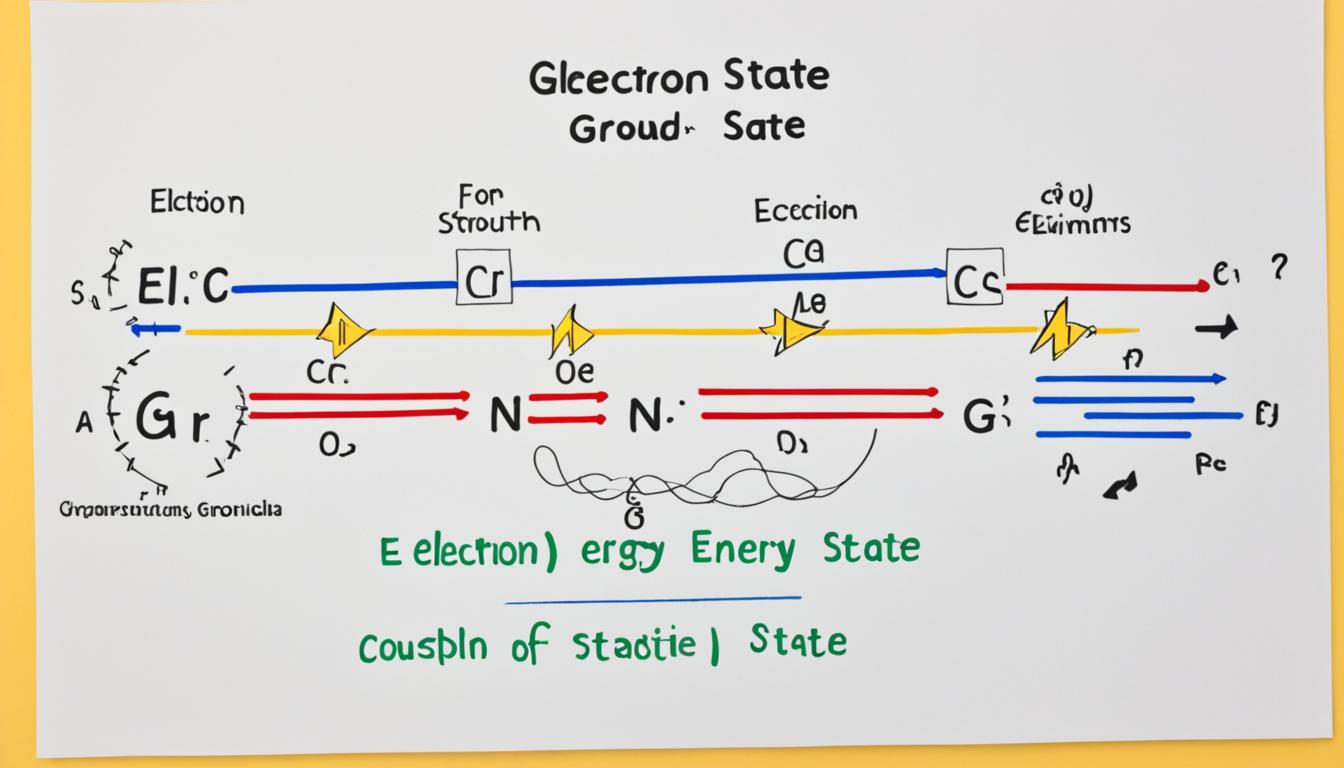The intricate world of atoms reveals fascinating behaviors as it strays from its lowest energy, introducing us to the concept of excited state electron configurations. This transition is not merely a shift but a launch into a myriad of possibilities that redefine atomic potential. An electron’s quantum leap from the baseline—the ground state where it’s most stable—to an elevated realm of energy, marks an atom’s entry into the excited state. Here, the complex choreography of electron configuration begins to dance to the tune of energy absorption, birthing new and dynamic chemical identities.
An atom in its quiescent ground state is like an orchestra at rest. But when energy—often in the form of a photon—pulses through, electrons leap into higher octaves of their energetic scale, creating the harmonics that are excited state configurations. This melody of movement not only underpins a fundamental understanding of atomic behavior but also unlocks the door to advance our knowledge in fields ranging from quantum physics to photochemistry.
Key Takeaways
- Excited state electron configurations represent electrons in higher energy levels than those in the ground state.
- Understanding excited state configurations is key to exploring atomic behavior under energy influence.
- The transition of electrons to an excited state leads to changes in an atom’s chemical properties and reactivity.
- Photon absorption is the primary catalyst for an electron’s jump to excited state configurations.
- Electron configuration in both ground and excited states is critical for predicting chemical and physical phenomena.
Basics of Electron Configuration in Ground and Excited States
Understanding the intricacies of an atom’s electrons starts with grasping the essentials of electron configuration. This involves not only knowing how electrons are distributed in the ground state but also recognizing the changes that occur during electron excitation. To thoroughly comprehend these concepts, we will delve into the definitions, compare energy levels and examine the visual elements such as energy level diagrams to foster a deeper appreciation of electron transitions and the concept of an excited state.
Defining Ground State Configuration
The ground state of an atom is its most stable, lowest energy configuration. Each element has a unique electron configuration that defines its position on the periodic table and dictates the chemical properties intrinsic to the element. Delving into the definition of ground state configuration is vital to predicting both an atom’s reactivity and its capability to bond with others.
The Phenomenon of Electron Excitation
When electrons absorb photons with adequate energy, they are promoted to higher energy levels. This state of higher potential is what scientists refer to as the excited state. The energization changing an electron’s position is foundational to our understanding of quantum mechanics and gives rise to phenomena such as luminescence and electron energy level transitions.
Visualizing Excitation through Energy Level Diagrams
An energy level diagram serves as a visual map of an atom’s energy states. Highlighting the energy levels, these diagrams depict potential electron transitions both in the absorption and emission of energy. Below is a tabular representation of the transitions between ground state and excited state, clarifying the interactions with photons during electron excitation:
| Energy State | Configuration | Interaction with Photons |
|---|---|---|
| Ground State | Lowest energy arrangement | None or minimal photon interaction |
| First Excited State | Elevated energy configuration | Absorption of photons |
| Second Excited State | Further elevated energy configuration | Absorption of higher energy photons |
| Return to Ground State | Reversion to lowest energy arrangement | Emission of photons |
Which Electron Configuration Represents the Electrons in an Atom’s Excited State?
Delving into the realm of atomic structures, we often encounter the term excited state configurations. These configurations provide valuable insights into the dynamic nature of electrons when influenced by energy absorption. Excited states are pivotal in explaining numerous chemical phenomena and can be expertly interpreted through lending lenses from Regents Chemistry.
Interpreting Excited State Configurations: Regents Chemistry Insight
Interpretation of excited state configurations is an integral part of Regents Chemistry, where a thorough understanding enhances a student’s ability to predict and explain an atom’s behavior when energy is introduced. By examining electron transition, we shed light on how an electron jumps from a lower to a higher energy level.

Case Study: Sodium’s Electron Transition to an Excited State
Sodium serves as an ideal candidate for examining an electron transition to an excited state. Its ground state configuration is well-documented, and the study of its transition reveals the orchestration of electrons as they absorb energy. We witness first-hand how a sodium atom, typically with a closed-shell configuration, adjusts to accommodate an electron in a higher energy orbit.
| State | Electron Configuration |
|---|---|
| Ground State | 1s2 2s2 2p6 3s1 |
| Excited State | 1s2 2s2 2p6 3p1 |
Rules Governing Electron Transitions to Excited States
The phenomenon of electron transitions to excited states is not arbitrary but is governed by well-defined rules. These rules, crucial in predicting the likelihood of such transitions, include specific angular momentum and spin considerations ensuring that only certain transitions are viable while others are strictly forbidden.
- Pauli Exclusion Principle
- Aufbau Principle
- Hund’s Rule
Recognizing these rules allows for an intuitive grasp of the possibilities inherent in excited state configurations and underscores the importance of selection rules in quantum chemistry.
Impact of Excited State Electron Configuration on Chemical Behavior
The concept of excited state electron configuration is pivotal in understanding the intricate behavior of atoms under various chemical contexts. When an atom’s electrons dwell in an excited state, the potential for change in its reactivity can be significant. Such a state happens when one or more electrons absorb energy and leap to higher energy levels than they occupy in a stable, ground state. This transient state alters the ways in which an atom can interact with its neighbors, effectively modifying its chemistry.
In terms of chemical behavior, an atom with an excited electron configuration may engage in reactions that are otherwise unfathomable when in its ground state. For instance, materials that are inert in their base form, like noble gases, can become reactive under excitation, permitting the formation of rare compounds. This reaction propensity not only plays a crucial role in synthetic chemistry but also in nature through photosynthesis, where sunlight propels electron excitation, fueling the conversion of carbon dioxide and water into glucose and oxygen.
Furthermore, understanding the relationship between an atom’s reactivity and its electron configuration in an excited state opens up pathways to manipulating chemical reactions for innovative applications. This includes the development of new materials, pharmaceuticals, and energy sources. The ability to predict and control these changes is the very foundation of chemical synthesis and the broader scope of chemical engineering. As such, delving into the dynamics of excited electron configurations equips scientists and technologists with deeper insights that could pioneer groundbreaking advancements in various industries.
FAQ
What are excited state electron configurations?
How do excited state electron configurations differ from ground state configurations?
What is the importance of electron configuration in understanding atoms in excited states?
What is ground state electron configuration?
How does electron excitation occur?
How can energy level diagrams help visualize electron excitation?
How can excited state configurations be interpreted in chemistry?
Can you provide a case study on electron transition to an excited state?
What rules govern electron transitions to excited states?
How does excited state electron configuration affect the chemical behavior of atoms?
Source Links
- https://socratic.org/questions/what-electron-configuration-represents-an-atom-in-the-excited-state
- https://www.transformationtutoring.com/single-post/which-electron-configuration-represents-the-electrons-of-an-atom-in-an-excited-state
- https://socratic.org/questions/what-electron-configuration-represents-an-excited-state





